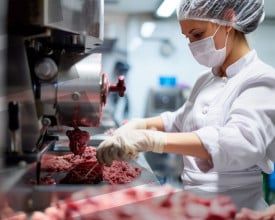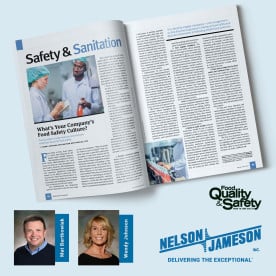foodborne illness
- February 24, 2021
Not only has COVID put a significant dent in our social lives, but it also has impacted many operations and practices throughout food processing facilities. Unfortunately, this
- September 28, 2020
September is Food Safety Education Month! According to the FDA, the importance of food safety is learning and educating others on taking an active role in preventing foodborne
- December 03, 2019
Wash. Your. Hands. This simple act can do so much to prevent the spread of viruses and bacteria. Lately, this has been highlighted most unwelcomingly
- January 09, 2019
Nelson-Jameson takes food safety very seriously, and we know that you do too. That is why we offer a wealth of products and solutions that can help your facility reduce the risk of foodborne illness and contamination. From Color-Coding and Metal Detectable to Hand Hygiene and Environmental Testing - we have many programs available to help ensure your processing facilities are compliant, providing safe, quality food to all.
To talk to one of our food safety experts about these programs or to receive
- June 17, 2016
Food safety concerns are on all food manufacturers’ minds (and, honestly, probably in their dreams too), so it is critical to know how bacteria grow. Armed with that knowledge, we are better able to stay ahead of bacterial contamination in the food manufacturing facilities.
Often, when I was in the plant environment, I would refer back to a case study put together by the Royal Society for Public Health in 2010. It laid out some excellent basics on growth factors for bacteria in a concise manner that readers
- May 26, 2016
What is the difference between water activity and water “moisture” content? Well, it all depends on what you want to achieve. Do you want to monitor the amount of water and dry matter present in a product? Or do you want to increase and monitor the shelf stability of a product?
“Water ‘moisture’ content is the amount of water contained in a product”. Measuring water “moisture” content is better used to determine quality of the process. For example, if the product is a cheese powder that is spray dried, it is common practice to measure the water “moisture” content to determine yield and to ascertain if your drying process is running according to the diagnosed plan.
- November 25, 2014
In our house, there are two camps when “Black Friday” hits: the "Dedicated Shoppers" and, those like myself, the “Thanks, I’m Not Giving Up” eaters.
The “Thanks, I’m Not Giving Up,” population, still basking in the glory of the stomach-stuffing of the previous day, shuns leaving the home in favor of recreating the glory of Thanksgiving though various helpings of leftovers throughout the day. Often, this is done in a traditional wardrobe of elastic-waist fleece pants and a hooded sweatshirt. In such regalia, the following exchanges may take place (in one's head):
Q: “Would I like a mound of reheated green bean casserole?”
A: “Please…I think it only gets better on the second day!”Q: “Care for some stuffing reanimated with a healthy dose of leftover gravy?”
A: "Well, it is the holiday season…”Q: “Can I fit the rest of the turkey leftovers into one sandwich?”
A: "Well, I suppose everyone else ate while they were out shopping…”Much like with Black Friday shoppers, it pays to plan, my fellow “Thanks, I’m Not Giving Up” eaters! As soon as Thanksgiving is over, start thinking strategy! To avoid making it a “Blech Friday,” (the natural enemy of seasonal reheat-aficionados) consider some of these tips from Diane Van, Food Safety Education Staff Deputy Director of the USDA Food Safety and Inspection Service:
- November 12, 2014
The June issue of the CDC’s Vital Signs discusses the disturbing fact, that when it comes to norovirus: “…the amount of virus particles that fit on the head of a pin would be enough to infect more than 1000 people.” Not only that, but this tough contender can withstand freezing, as well as temperatures up to 140˚F; it causes 19-21 million illnesses in the United States alone; and it holds the championship belt for being the “most common cause of foodborne-disease outbreaks in the United States”!
However, norovirus does not have to prevail this winter (a time when the illness frequently shows up). One simple, but very effective treatment is out there that can limit the spread






